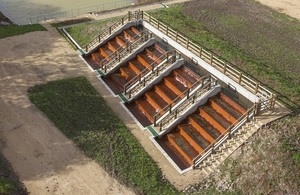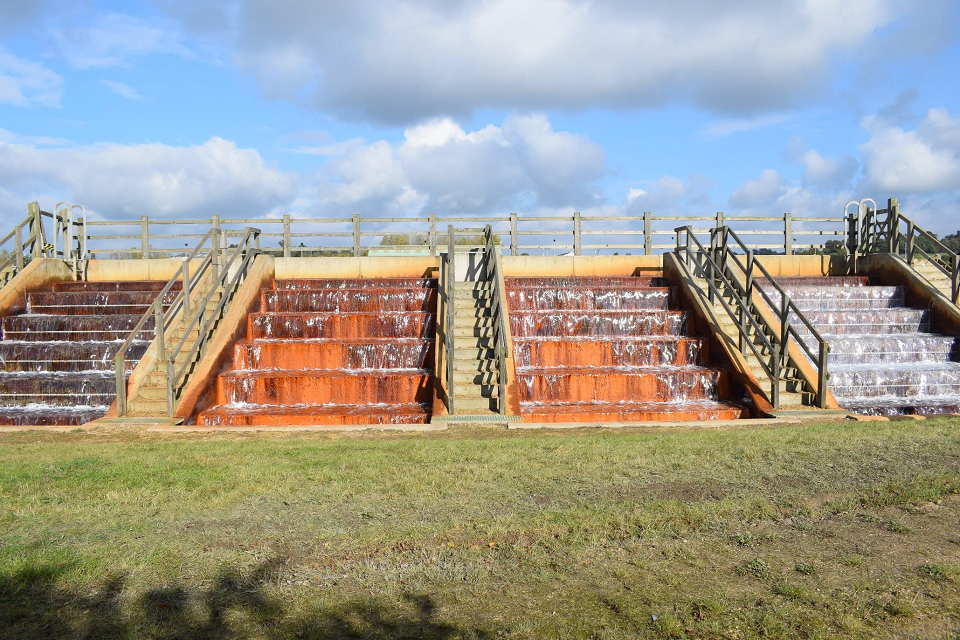Improving efficiency at mine water treatment schemes
The Coal Authority is working with scientists from the University of Sheffield to research materials to improve the efficiency of mine water treatment schemes.

The water cascades at the mine water treatment scheme
The Coal Authority, which manages Britain’s coal mining legacy, employs contractors to clean water cascades and pipework across its 75 mine water treatment sites on a regular basis.
The manual ‘wash and brush-ups’ are needed to prevent a build-up of iron solids (ochre) that are produced as part of the treatment process. The ochre clogs up the system and reduces the effectiveness of the treatment scheme that pump the water out from disused coal mines.
In a move to reduce costs, the Coal Authority is working with Dr Maria Romero-Gonzalez and her research group in the Department of Geography at the University of Sheffield, in a 6 month trial of new super hydrophobic materials that will aim to repel the ochre and prevent it from clogging up the treatment systems.
“Hydrophobic materials are nothing new,” explained Dr Chris Satterley, Technical Research and Development Manager for the Coal Authority. “But the most recent generation of super hydrophobic materials are now available commercially and we want to see whether they will help us to improve the efficiency of our operations.
“Currently we need to regularly remove the build-up of ochre, which obstructs the process of the schemes. But if this simple process works, it could be a significant development for our on-going maintenance programme.”
Various hydrophobic materials were tested in laboratory conditions by Maria and her team and 2 were selected to be used on site at the A Winning mine water treatment scheme in Derbyshire.
“It worked very well in the laboratory but now we need to see if it is just as effective out in the open and on site,” added Chris. “Initial observations show that the coating is working and is repelling large solids and ochre flocs. But it is still early days and we will be working closely with our University of Sheffield colleagues to see how it works over a longer period of time.”
The mine water treatment schemes run by the Coal Authority are all individual and depend on the amount of water being pumped out of disused coal mines and the local geology. Typically, they comprise of water cascades, a series of settlement lagoons and reed beds. They treat around 122 billion litres of water each year and prevent 4,000 tonnes of iron solids from entering local watercourses and also protect important sources of drinking water for local communities.
At the treatment scheme located at the site of the former Blackwell A Winning pit at South Normanton, there are 4 water cascades. For the trial, one was fully cleaned and coated for testing, a second has also been cleaned to act as a control and the remaining 2 are continuing under the current maintenance regime for comparison.

The four water cascades at the mine water treatment scheme
Further testing and studies will also be carried out on a series of concrete slabs installed in the cascades. One sample will be retrieved every week for the first month followed by monthly sampling for the remainder of the 6 month trial.
Dr Maria Romero-Gonzalez, Director of the Environmental Science Programme at the University of Sheffield, said: “This is a unique opportunity to study the durability and performance of the coatings under a variety of weather conditions.
“We will use electron microscopy and other surface analysis techniques to investigate the efficiency of the coatings at surface level. This will help us to assess how good the coating is and evaluate its application for treating ochre accumulation. The results will allow us to estimate the technical and economic benefits of using coatings for treating mine water, providing the Coal Authority with innovative solutions for the future.”